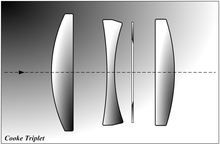Cooke triplet
 | |
| Introduced in | 1893 |
|---|---|
| Author | Dennis Taylor |
| Construction | 3 elements in 3 groups |
| Aperture |
f/3.5 (early) f/2.8 (rare-earth optical glass) |
The Cooke triplet is a photographic lens designed and patented (patent number GB 22,607) in 1893 by Dennis Taylor who was employed as chief engineer by T. Cooke & Sons of York. It was the first lens system that allowed elimination of most of the optical distortion or aberration at the outer edge of lenses.
Design
A Cooke triplet comprises a negative flint glass element in the centre with a crown glass element on each side. In this design, the sum of all the curvatures times indices of refraction can be zero, so that the field of focus is flat (zero Petzval field curvature). In other words, the negative lens can be as strong as the outer two combined, when one measures in dioptres, yet the lens will converge light, because the rays strike the middle element close to the optic axis. The curvature of field is determined by the sum of the dioptres, but the focal length is not.
At the time, the Cooke triplet was a major advancement in lens design. It was superseded by later designs in high-end cameras, but is still widely used in inexpensive cameras, including variations using aspheric elements, particularly in cell-phone cameras.
Application
The triplet soon became a standard in lens design still used with low-end cameras today. The main optical manufacturers often further developed the original Cooke triplet (e.g., the Zeiss Triotar) that were produced for many decades.
Binoculars as well as refracting telescopes often use triplets. The same holds for many projection lenses, e.g., for 35 mm slide projectors.
-

Triotar-Triplet on a Rollei scale-focus camera
-

Projection objektive Patrinast for a 35 mm slide projector by Ed. Liesegang; 1:2.8/85
-

Projection objective Maginon by Wilhelm Will, Wetzlar, 1:2.8/100